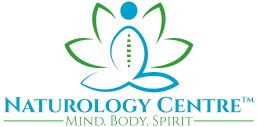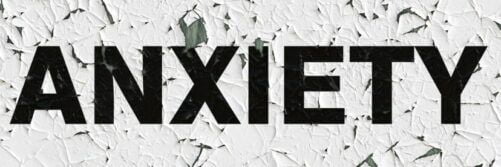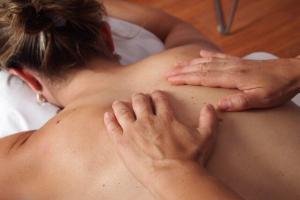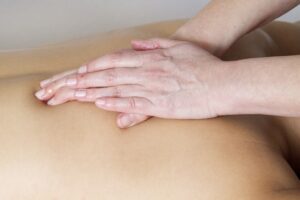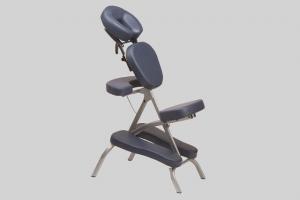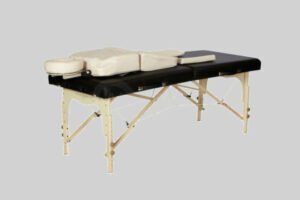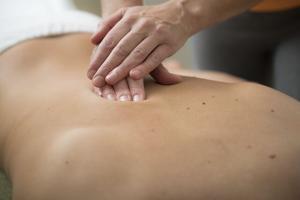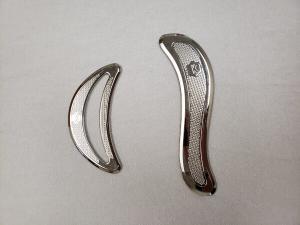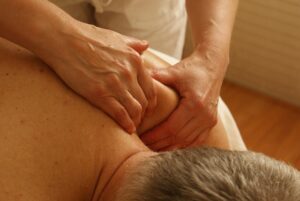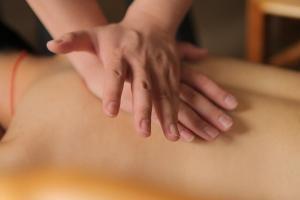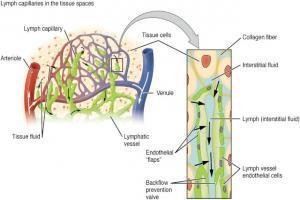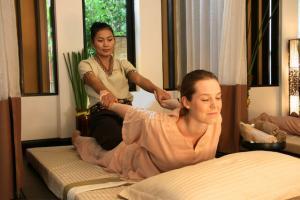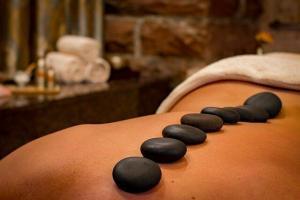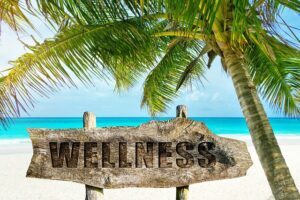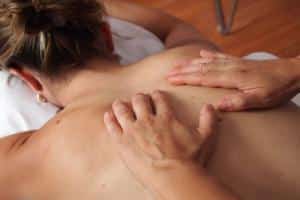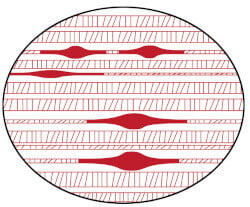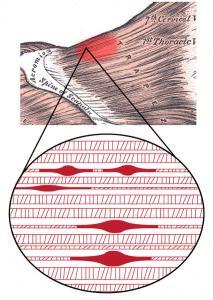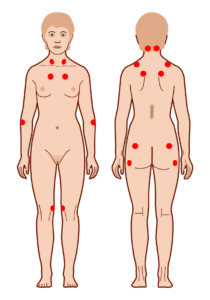Muscle knots are hard, sensitive muscle areas that tighten and contract even when the muscle is relaxed. When these tense muscle fibres are touched, they can cause pain in other parts of the body. They’re also commonly referred to as trigger points.
Various factors can cause painful muscle knots (trigger points):
• Sedentary Lifestyle
• Bad Posture
• Overuse or Injury to your Muscles
Muscle knots can occur anywhere in the human body, but they are most common in the back, neck and shoulders. They can frequently appear in your gluteal muscles as well. At times muscle knots can be caused by dehydration, poor eating habits, stress, and anxiety.
Aching and pain in your muscles and joints can be caused by muscle knots. A muscle knot may feel swollen, tense, or bumpy when touched. It may feel tight and contracted even when trying to relax, and they’re often sensitive to touch. The affected area may become inflamed or swollen as well.
Muscle knots can cause symptoms in areas other than the muscles, such as:
• Headaches
• Earaches
• Toothaches
You may also experience anxiety, stress, and depression, as well as sleeping difficulties.
Helpful at Home Treatments
It can take some time to treat muscle knots. You’ll need to break up the knotted tissue and relax inflamed nerves to eliminate the knots. Below are some things you can do to break up the knots and find relief.
Self-massage
You may be able to massage the sore muscles yourself in some cases. Locate the muscle knot and gently massage it with your fingers. Make small circles with your fingers and press firmly into the affected area. Make small circles with your fingers and press firmly into the affected area. Focus on loosening up the tight muscle fibres and relieving tension while massaging.
To apply more pressure to the knot, place a tennis ball between your back and the floor or wall and roll back & forth on the ball—experiment by moving the ball slowly and gently to apply pressure to points of tension. A soft or rigid foam roller can be used the same way but is usually on the floor.
Resting
If you have muscle knots, give your body some time to rest. Take a break from any activities causing the knots or making you feel more pain or discomfort. Allow yourself time to unwind! This could include sleeping for more extended periods than usual or lying in a comfortable position with pillows to support your body.
Stretching
Gently that elongates your muscles can assist you in releasing tension in your body. While stretching, be gentle with your body. Do not force yourself into any positions or engage in activities that cause pain. It’s usually recommended to hold your stretches for at least 30 seconds and slowly release the stretch to reduce your risk of injury.
Exercise
Aerobic exercise may aid in the relief of muscle knots. If you have knots in your shoulders or neck, do jumping jacks, swimming, or any other arm movements that will work your shoulders and neck muscles. This stretches the muscles and increases blood supply to them. Increased blood supply aids in the repair of damaged tissue.
Therapy with hot and cold temperatures
Using a combination of heat and cold to relieve pain and inflammation caused by muscle knots can be beneficial. Cold helps to constrict blood vessels, reducing swelling. Use a cold compress for 10 minutes, then remove it for at least 15 minutes to apply cold. You can keep doing this until you start to feel better. Heat relaxes and loosens stiff muscles, as well as alleviates pain. Heat has been shown to increase blood flow, which aids in healing. Use a heating pad or a warm bath to apply heat. Alternate between cold and heat treatments, or use the one that suits you best. Hot and cold therapy should be combined with other therapies.
Apply a muscle rub
Muscle rubs aid in the softening and relaxing of muscle knots. Massage a muscle rub into the affected area twice a day for cooling relief. You may require the assistance of another person to apply to difficult-to-reach areas. It’s usually best to perform a patch test before using a rub for the first time. Apply a little ointment to the inside of your forearm to perform a patch test. Wait about 24 hours to ensure that there is no reaction. If no response, you can safely apply it to other parts of your body.
Professional Massage Therapy for Trigger Point Pain Relief
Therapeutic Massage Therapy
It’s well known that massage can be used to treat muscle knots. Massage therapy improves blood flow and circulation. This can help improve muscle function and loosen your muscles. This aids in the relief of pain and stiffness. Once you see results, you can spread out your sessions. Remember that one session isn’t usually enough to heal you completely. You’ll most likely need several frequent sessions.
Massage can be classified into several types. The type that will benefit you the most will be determined by the severity of your muscle knots as well as your personal preferences. You may need to try several massages or manual therapy types before finding one that you enjoy and benefit from.
Pressure release at the trigger point
Pressure is applied to your trigger points for this therapy to work. A massage therapist or skilled practitioner will apply pressure to the muscle knot until it softens and releases. This will aid in the retraining of your muscles. Following a treatment session, you will be given a set of movements to perform at home.
Swedish massage therapy
If you have a lot of tension or are sensitive to touch, this gentle massage technique is for you. Long strokes, kneading, and deep, circular movements are used in Swedish massage. Vibration and tapping are also used to help people relax.
Massage of the deep tissues
This type of massage employs strong strokes to relieve chronic muscle tension. It is designed to work on the deeper muscle and connective tissue layers. It is frequently used to treat muscle damage caused by injuries.
Massage therapy for athletes
This massage technique is designed specifically for athletes and it has the potential to prevent or treat sports-related injuries.
Physiotherapy
A physical therapist can help you determine the root causes of your muscle knots. They will treat your pain with treatments that are appropriate for your situation. Physical therapy may be recommended in more severe cases. Techniques for reducing pain and preventing it from recurring will be taught.
Prevention Tips
Here are several methods for preventing muscle knots:
• Maintain good posture in your daily life. Avoid slouching while sitting relaxedly, with your shoulders back and down.
• Get plenty of rest and physical activity.
• When exercising, be sure to warm up and cool down and avoid overexertion. Remember lifting too heavy or running too fast can result in injuries and muscle knots.
• Sit for short periods. Take a break, get up, and move around every hour of prolonged sitting.
• While engaging in physical activities, be mindful of your body’s alignment. Simple stretches should be done to keep your muscles from becoming tight throughout the day. Exercises can even be done while sitting at a desk or watching television.
• Drink plenty of water and eat a healthy diet rich in calcium, potassium, and magnesium. Substitute fresh, whole foods for processed foods.
• Consider getting massages regularly to help you relax, gain flexibility, and keep your muscles in good shape.
When should you seek medical assistance?
Muscle knots that go untreated can cause chronic pain and other health problems. If you’ve tried everything to relieve your muscle pain and it’s still there, see your doctor. Call your doctor if your pain becomes severe and interferes with your daily life or well-being.
It’s possible that what appears to be a muscle knot is a swollen lymph node. A swollen lymph node is usually accompanied by other colds, coughs, or infections.
Consult your doctor if you have a worsening muscle knot, aren’t improving with treatment, or interfere with your mobility.
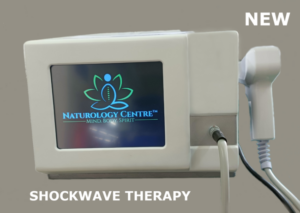
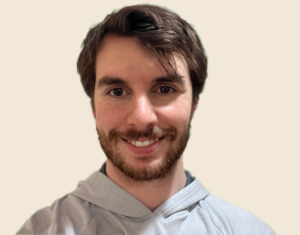
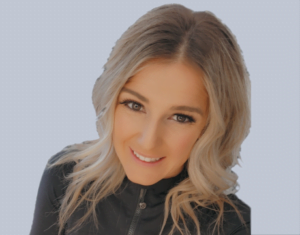
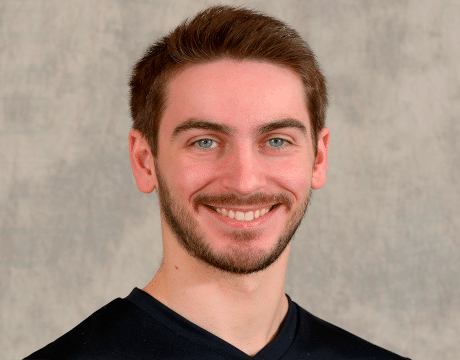
![]() Visit: https://naturology.noterro.com/
Visit: https://naturology.noterro.com/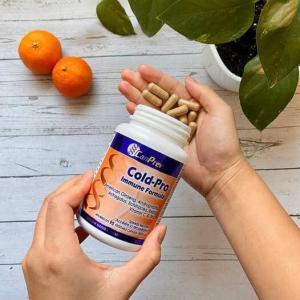 HANCE TO WIN A FREE BOTTLE of Cold-Pro (Reg. $27.99)!
HANCE TO WIN A FREE BOTTLE of Cold-Pro (Reg. $27.99)! 


